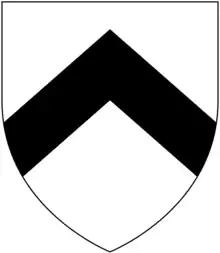Trelawne
Trelawne (Cornish: Trevelowen, meaning elm-tree homestead[1]) is an historic manor in the parish of Pelynt in Cornwall, England, situated 20 miles (32 km) west of Plymouth, Devon and four miles (6.4 km) west-northwest of Looe, Cornwall. It was long the seat of the Trelawny family, later Trelawny baronets, one of the most eminent of Cornish gentry families, much of whose political power derived from their control of the pocket borough of nearby East Looe.[2] The surviving grade II* listed[3] manor house known as Trelawne House is today used for holiday accommodation and entertainment, under the name "Trelawne Manor Holiday Park".[4]
Trelawne manor
Trelawne manor dates back to Norman times when it was held by Rainald de Vautort. It later passed in turn to the Cardinans, the Chapernouns and the Bonvilles. In 1554 the estate was confiscated from Henry Grey, Duke of Suffolk, the father of Lady Jane Grey and sold in 1600 to Sir Jonathan Trelawny, whose family had originated at Trelawny in Altarnun. It then passed down in the Trelawny and Salusbury-Trelawny families for several generations, many of whom were MPs for the local pocket constituencies of East and West Looe, Sheriffs of Cornwall and Lord-lieutenants of the county.[5] Since John Trelawny, son of the original purchaser, who was created a baronet in 1628, there has been an unbroken series of 14 Trelawny or Salusbury-Trelawny baronets.
Trelawne House
The Grade II* listed house, which includes elements dating from the late 13th century, has been extended and remodelled several times since then. The entrance tower and hall, since remodelled, was built c.1450 for the Bonville family. The west range was added in c.1700 and there were at one time similar ranges to the east and south. After a fire c.1759 a new south east wing was added by Edward Trelawny. In 1860–62 Sir John Trelawny commissioned the rebuilding of the chapel and the south front.[5]
For five years from 1767 to 1772 the house stood empty because the owner, Sir William Trelawny, 6th Baronet, was Governor of Jamaica and there was much debate as to whether the window tax was therefore payable. It was eventually decided that it was.[6]
In the 1960s the estate became a holiday caravan park.
![Trelawne House today[when?]](../I/Trelawne_Manor_(geograph_2361015).jpg.webp) Trelawne House today
Trelawne House today Arms of Trelawny of Trelawne: Argent, a chevron sable[7]
Arms of Trelawny of Trelawne: Argent, a chevron sable[7]
References
- "Trelawne". Akademi Kernewek. Cornwall Council. Retrieved 16 May 2022.
- History of Parliament: House of Commons 1715-1754, ed. R. Sedgwick, 1970
- Stuff, Good. "Trelawne House, Pelynt, Cornwall". www.britishlistedbuildings.co.uk.
- "Trelawne Manor Holiday Park". www.visitcornwall.com.
- Historic England. "Trelawne House (1140729)". National Heritage List for England. Retrieved 20 September 2018.
- Taxes, Office for. Cases of Appellants Relating to the Duties on Houses, Windows, Or Lights. p. 78.
- Kidd, Charles, Debrett's Peerage & Baronetage 2015 ed. London, 2015, p. B796